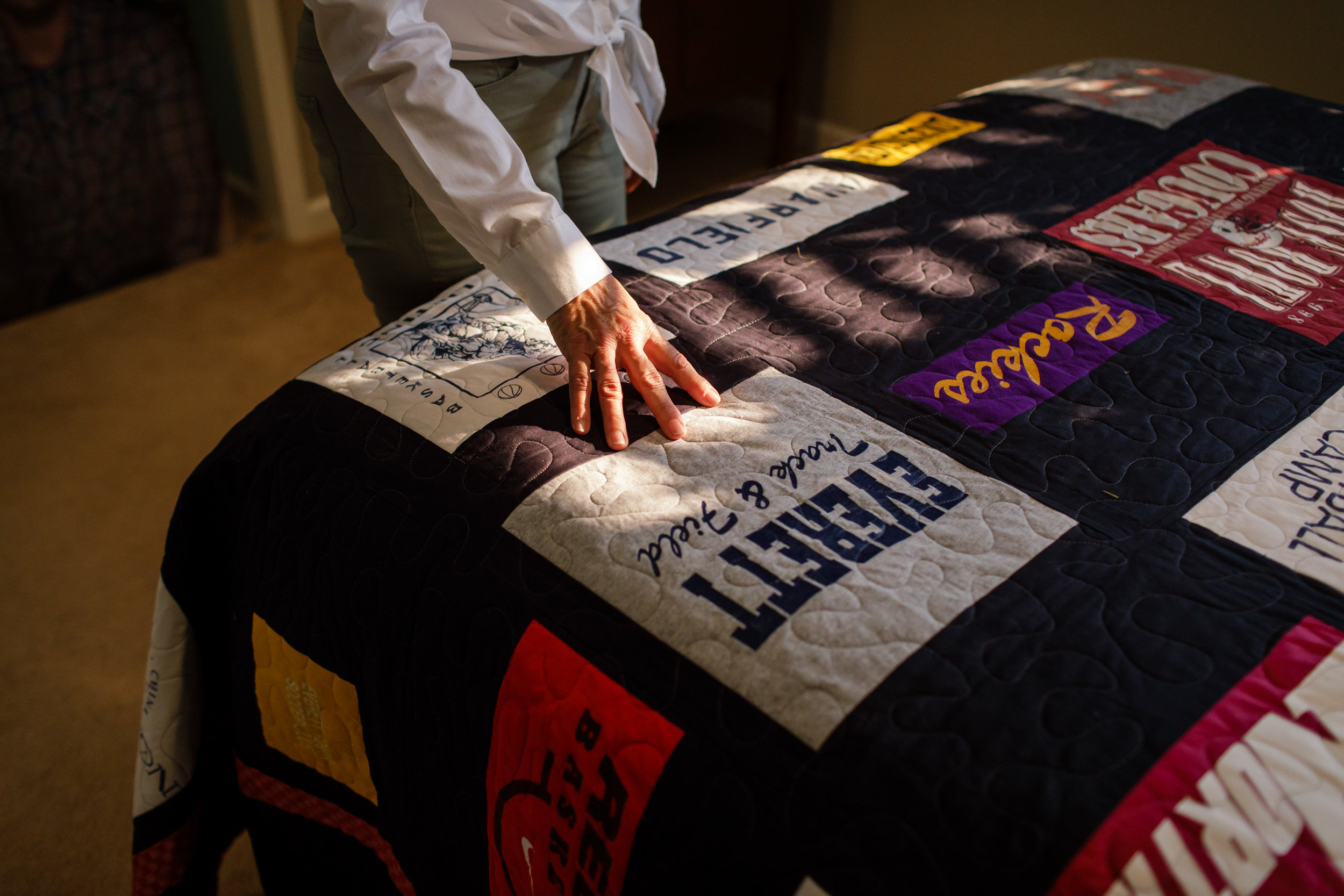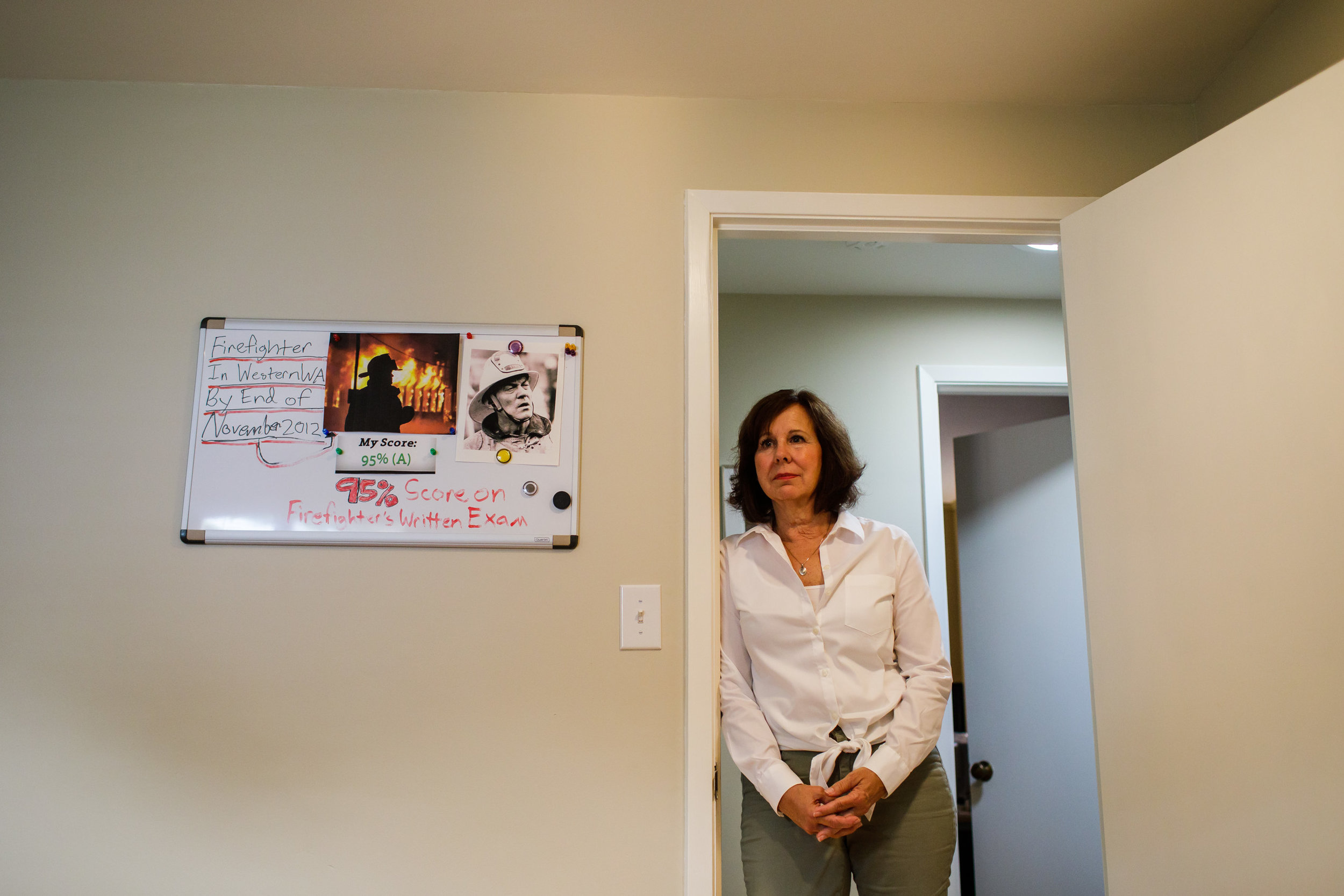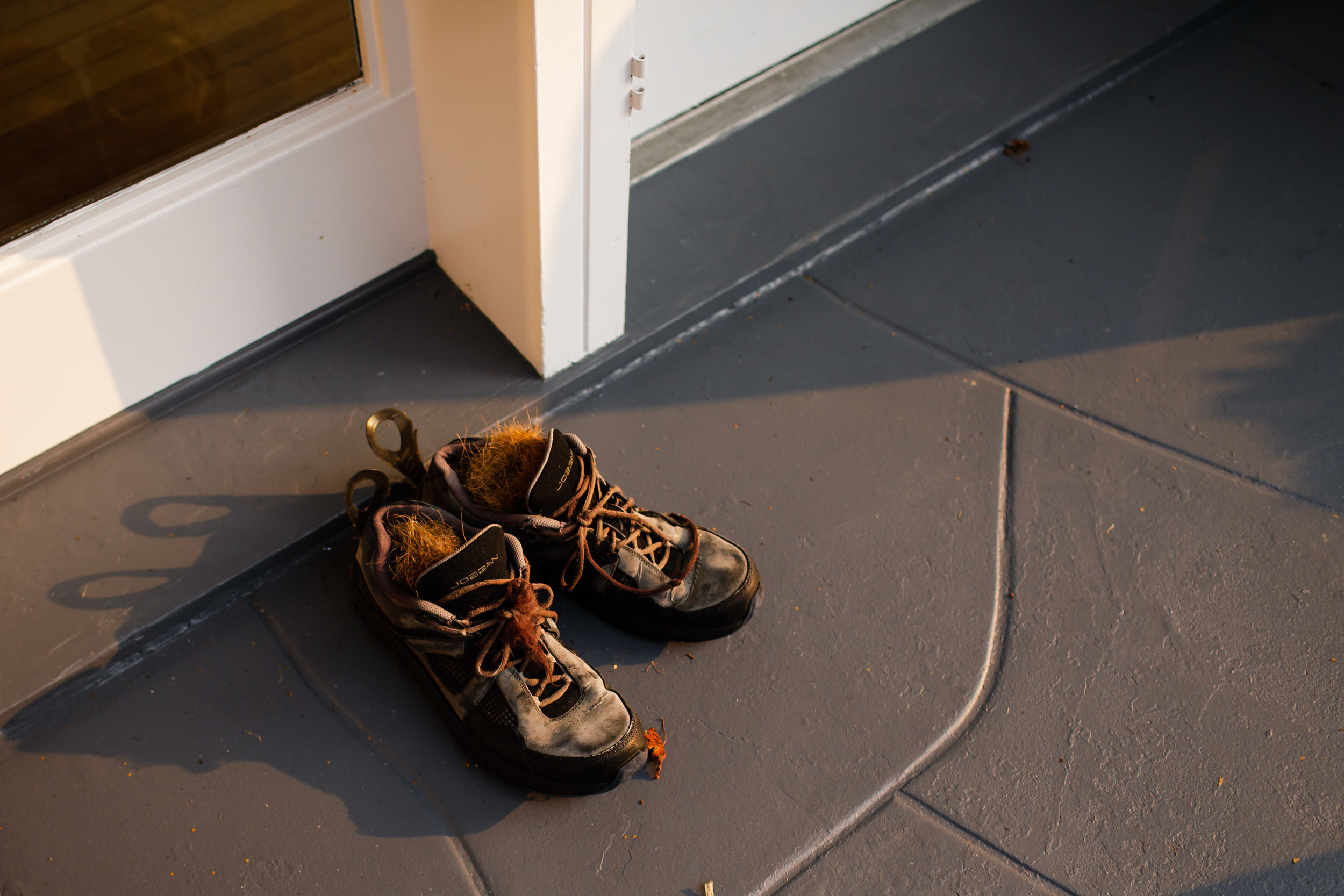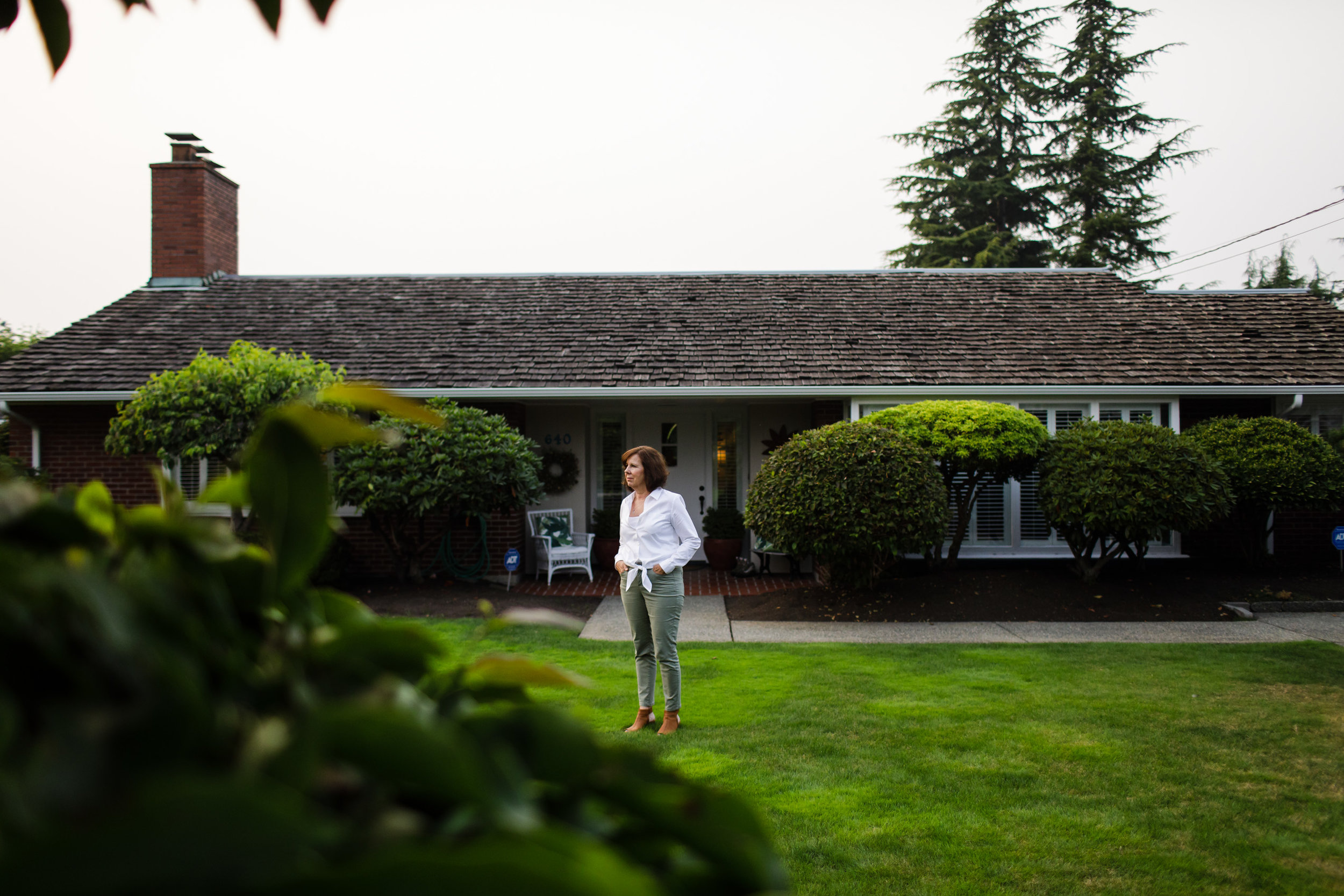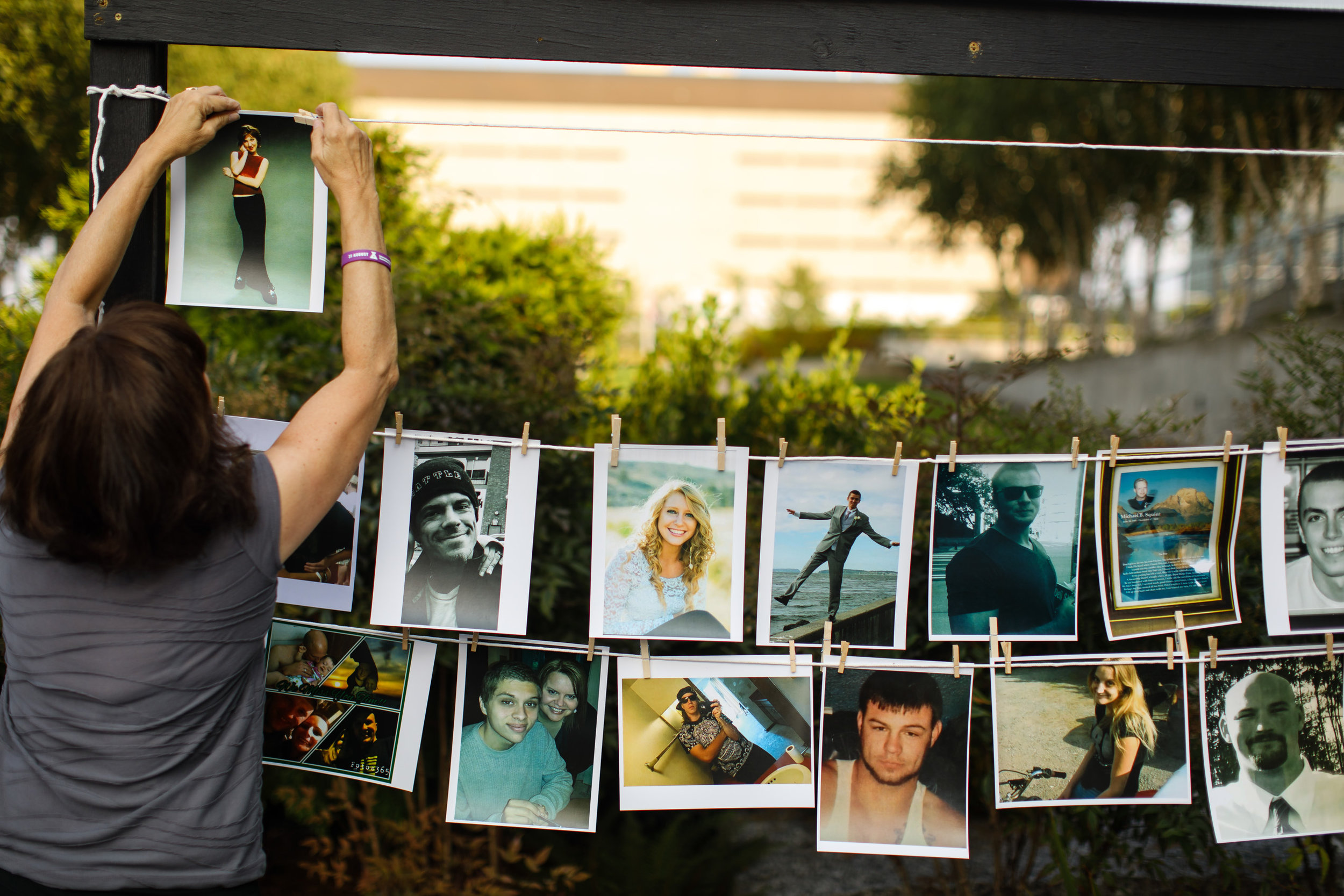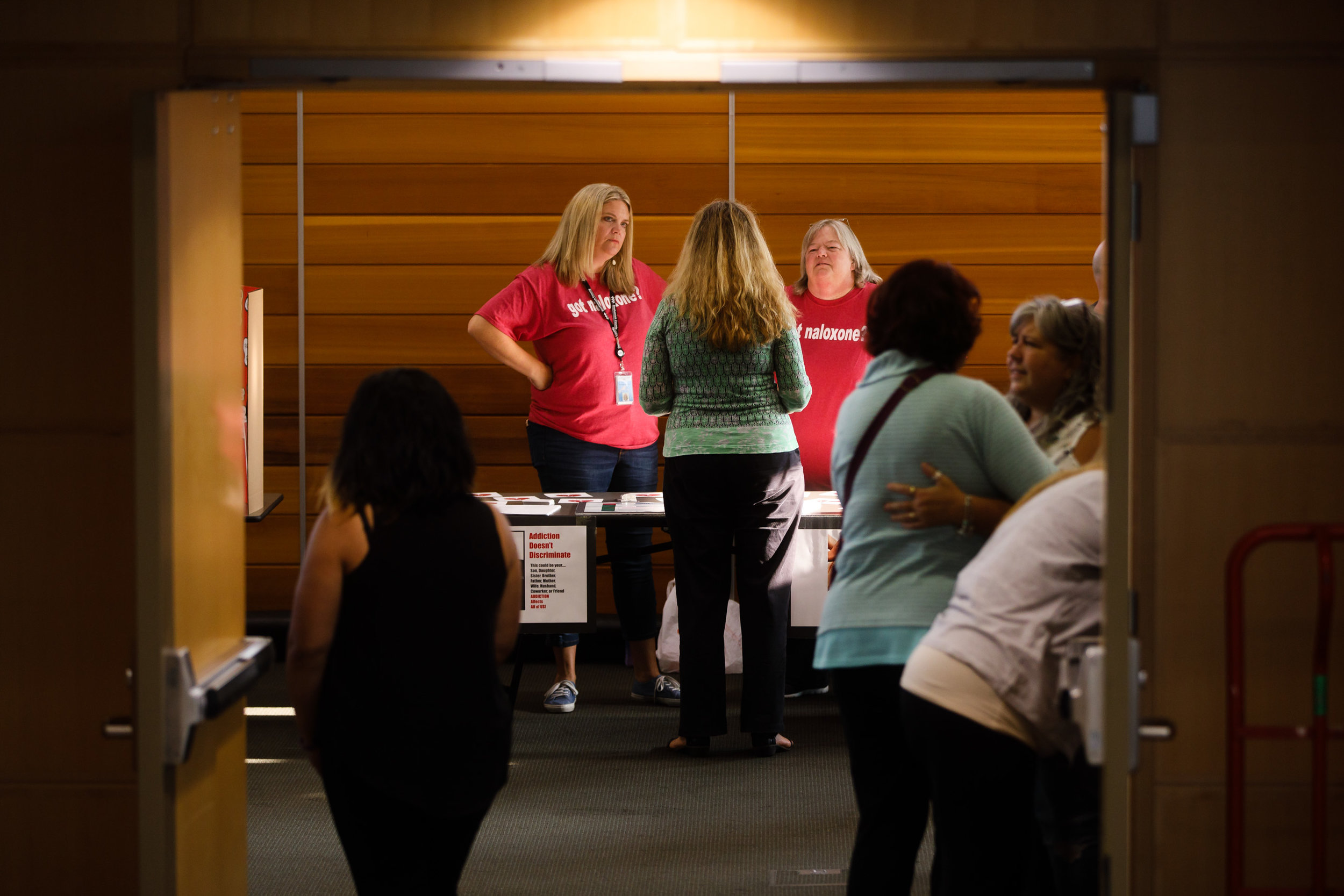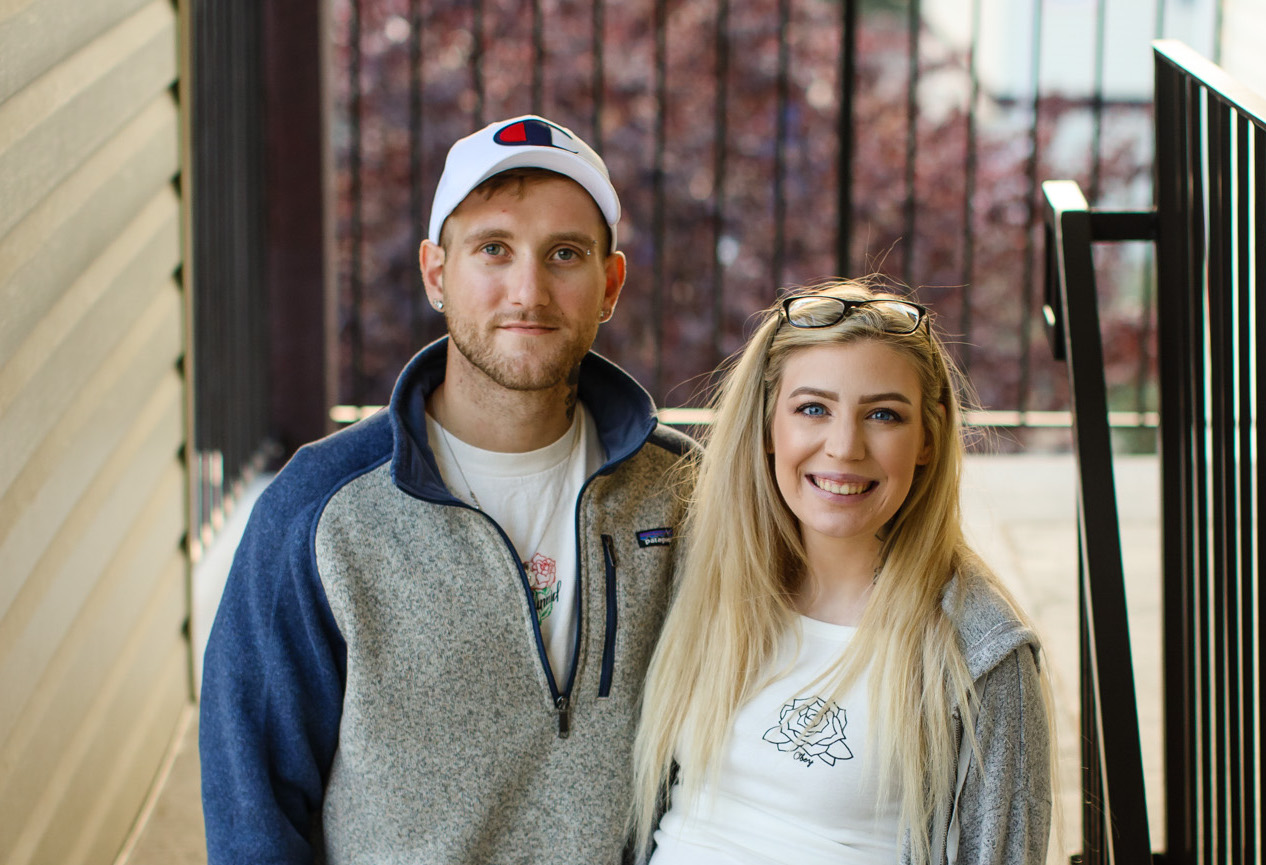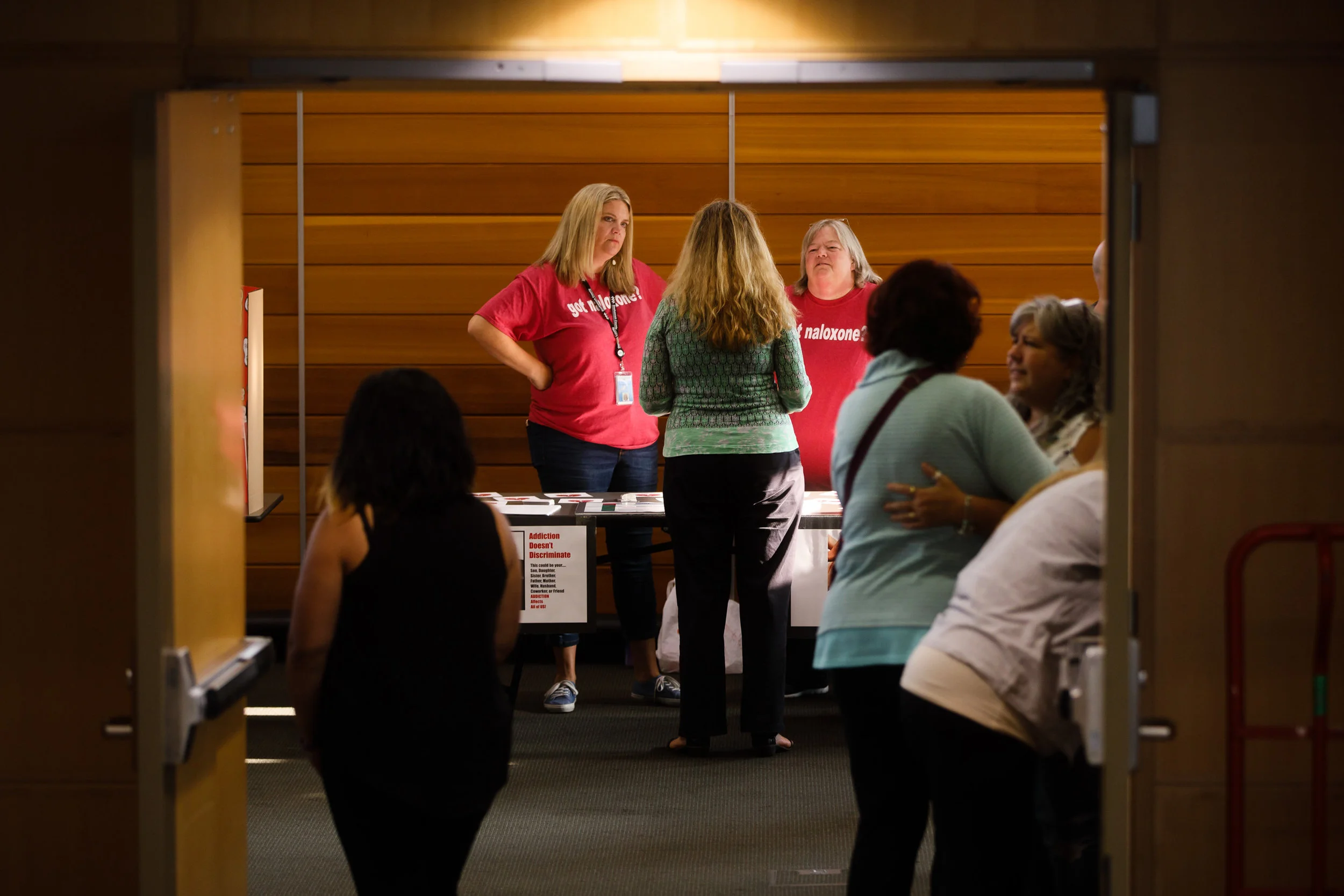get naloxone to everyone you can
Season 1 Episode 2: A life-saving nasal spray
SOLUTION:
Get the overdose reversal drug, naloxone (aka Narcan) into the hands of everyone who has opioid use disorder or knows someone who does, and train them how to use it. Family, friends and people with addiction themselves can play a big role in stopping overdose death.
STORY:
A life lost, a life saved. The main character of this episode isn’t a person. It’s a nasal spray. Naloxone (aka Narcan) saves lives from opioid overdoses (heroin, painkillers, fentanyl). Across the U.S. people are dying from opioids, but their deaths are preventable. We walk you through how to save a life using the overdose antidote.
This season we’re in Snohomish County, Washington which has an oversized share of overdose deaths in the state and is now treating the opioid epidemic like a natural disaster.
Drawn by producer Julia Drachman
LINKS TO MORE INFORMATION AND RESOURCES:
Snohomish County overdose and addiction treatment resource guide.
Learn to administer Naloxone through an online training.
Learn more about Naloxone and the different forms it comes in.
Research: Family members can be life savers.
Research: One study found 61% of drug overdoses occurred at home.
TRANSCRIPT
TRANSCRIPT OF FINDING FIXES: EPISODE 2
(Click the play button at the top of this page to listen)
Anna Boiko-Weyrauch: The main character of this episode isn’t a person. It’s a nasal spray. Yes, a nasal spray. Not just any nasal spray. It’s a life-saving nasal spray. And it’s name is Naloxone. Sometimes it goes by the brand name Narcan. Sometimes it assumes a different form, too. Naloxone takes form as an injection.
When this medication gets onto the scene of an overdose, it saves lives. You spray it up someone’s nose or poke them in an arm or leg. The antidote goes to work and stops an overdose from opioids like painkillers or heroin.
This episode we’re focusing on Naloxone. It’s a solution to stop people from dying.
This is Finding Fixes—a podcast about solutions to the opioid epidemic.
I’m Anna Boiko-Weyrauch.
Kyle Norris: I’m Kyle Norris.
In April 2018, the US Surgeon General urged everyone in the U.S. to keep Naloxone on hand if they use opioids or if they know someone who does.
After the episode, we’re going to walk through instructions on how to get Naloxone in Washington state and how to use it. So stick around for that.
And get this, our assistant producer, Julia, drew step-by-step instructions of how to recognize the signs of an overdose and give someone Narcan. Like a graphic novel, but it’s 2 pages. You can find that in our show notes or at our website findingfixes.com.
First, here’s Anna with today’s episode.
Boiko-Weyrauch: We’re going to the location of one overdose—and it’s not a back alley.
(Rustling sounds)
Debbie Warfield: So today is Saturday, March 10th.
Boiko-Weyrauch: Debbie Warfield recorded this for us on her phone.
Warfield: I'm standing in our son Spencer's room who died from an overdose, October 14, 2012.
Boiko-Weyrauch: Spencer was 24. He was 6’5” and a track and field star.
Picture of Spencer in front of his clothes and other belongings.
CREDIT: LEAH NASH FOR FINDING FIXES »
Warfield: And I finally decided this is the day that I'm going to come in and kind of go through this room and decide what needs to be done, and what I'm going to do with some of his things. I still have all of his clothes and his shoes. He loved tennis shoes. He had a size 15 foot.
Boiko-Weyrauch: Debbie lives in a neighborhood with manicured hedges, near the waterfront, where every house just looks perfect.
Her son Spencer died in this room. It happened overnight, and Debbie didn’t get to him until too late. She says she feels guilty because no matter what the family did, it wasn’t enough to keep him alive.
Debbie Warfield in her son Spencer’s room.
CREDIT: LEAH NASH FOR FINDING FIXES »
Warfield: I've taken everything out and I'm just starting to paint the walls.
Boiko-Weyrauch: Since then, Debbie has become a voice in her hometown Everett, Washington advocating for better treatment.
The reason we want you to meet Debbie is that over half of all overdoses happen at home. Overdoses happen in seemingly safe places and they happen quietly. People die from opioids in basement rooms like this one. With carpet and walls painted beige.
Warfield: I’ve decided to use the same color paint.
Boiko-Weyrauch: Friends and family members like Debbie are often the first on the scene when someone overdoses. Research suggests family members can be life savers.
Warfield: So that’s kind of what I’m doing this Saturday. Always being in Spencer’s room, just all the memories all the hopes for him. It’s just really difficult to go through, so anyway I’m going to get back to my painting and I will check in later.
Boiko-Weyrauch: Listening to that audio recording from Debbie made me sob like a baby.
By the time the EMTs arrived to help Spencer, it was already too late to administer Naloxone. Or at least that’s what Debbie says they told her. Now, looking back, she says she would have demanded it. It’s a regret she carries through life.
There is a lot more to her story, that we won’t go into now.
What you need to know is this. This is what’s at stake. People dying from opioids at home, being found by their mothers. These deaths are preventable.
For the past three years, Snohomish county has been getting Narcan into the hands of everyone they can: law enforcement, first responders, even librarians.
This season we’re focusing on Snohomish County. It has an outsized share of the number of overdose deaths in Washington state.
Also, Snohomish County is one of the only counties in the country that is treating the opioid epidemic like a natural disaster. Narcan is part of its response.
We got a look at how they’re doing that about 30 miles north of Seattle, in suburban Lynnwood, Washington. It was a sunny spring evening.
Amy Austin: It’s like the first sunny day in like a really long time, so thank you for coming here tonight.
Boiko-Weyrauch: Amy Austin stands at the front of a packed meeting room. Almost every chair is filled and people are standing in the back, taking notes.
She holds up a small white plastic spray bottle, and squeezes.
Austin: It’s just one click (click) and that’s it, ok?
Boiko-Weyrauch: A mist of liquid squirts a few feet into the air. That’s Naloxone, the star of this episode.
A vial of Narcan handed out at the training.
CREDIT: ANNA BOIKO-WEYRAUCH »
Boiko-Weyrauch: Amy works for Snohomish County and her job is to educate the public about opioids, doing community training like this.
She walks the audience through some bullet points on how to recognize the signs of an overdose.
Austin: The person will have pale and clammy skin. They could have infrequent or no breathing. They'll have a deep snoring or gurgling sound, sometimes considered the death rattle. And they're not responsive to any type of stimuli.
Naloxone information booth.
CREDIT: LEAH NASH FOR FINDING FIXES »
Boiko-Weyrauch: Opioids like painkillers and heroin slow the body down. Too much slows your breathing down, way down. Overdosing is like dying of suffocation—your fingernails turn blue, you turn pale, you can’t breath, and you don’t respond when someone yells at you.
Amy explains how Naloxone works with some powerpoint slides of a brain with little animated balls that pop onto the top of corkscrew-ice-cream-cone-looking shapes. They represent what’s going on in your brain.
The takeaway is that an overdose happens when your brain is filled with more opioids than it can handle. The opioids have attached themselves to every available receptor in the brain. So what the Naloxone does is it knocks the opioids off the receptors.
(Breathing sound)
That lets you breathe again.
By the way, Naloxone is only for opioid overdoses. It doesn’t work other drugs like cocaine or meth.
Austin: This slide is very telling. This is last year…
Boiko-Weyrauch: At the training, one powerpoint slide really stuck out to us. It shows the number of patients who came into the local E.R. recently because of an overdose.
Austin: The reason I think this slide is so telling is—look at this.
Boiko-Weyrauch: Amy points to the slide. It shows the ages of the patients. Close to half of people who overdosed were over the age of 60. Almost half of ODs.
Austin: Who can overdose on opiates? Anybody. Anyone that takes an opiate is at risk for an overdose.
Boiko-Weyrauch: That includes prescription painkillers. You don’t have to be on heroin to overdose on opioids, even accidentally.
Austin: So I can’t remember if I took a vitamin this morning. If I’ve got seventeen pills that I need to take and, you know, I’m unsure I've taken them it's a high risk that I would maybe take another one.
Boiko-Weyrauch: And that’s where an overdose could occur. So, the county has started going to senior centers and doing Naloxone trainings there.
Over the past three years, Amy and her colleagues have trained about 2,000 people across the county in workshops like this. And the county has distributed over 1,300 doses of Naloxone.
At the end of the evening, the trainers hand them out for free: one box with two doses.
(Group of people talking indistinctly)
Austin: OK, alright, thank you very much. I’m glad you joined us.
Boiko-Weyrauch: In the audience are members of the public. They have a lot of reasons for wanting their own box of Naloxone, or Narcan.
Attendee 1: The idea of having something in my pocket or in my car if I see it if I see an incident happening that I could actually intervene, maybe I can actually do something to help somebody.
Attendee 2: Everybody should have Narcan. It should be something that’s in every medicine cabinet, I think, and in every home, because look at all the ways that overdoses can happen.
Attendee 3: I’ve worked with homeless people for many years and I still do so it's a good thing for me to have with me.
Boiko-Weyrauch: The producers of this podcast carry Naloxone too now. We put our signatures on a piece of paper and walked out with our very own small box.
I got it because I’ve seen people injecting heroin in doorways around Seattle. We spend time with people who have opioid addiction.
I keep one vial of Naloxone in my purse and another in the bag with all my radio gear.
I think of it like a defibrillator or fire extinguisher. It’s a good feeling to know it’s around and if I it came to it, I could save a life.
Our team hasn’t needed to use our supply of Naloxone, or Narcan, so far, thankfully. But one woman we’re following in this podcast has a bit of experience with it.
Hallie Martin has used Naloxone to save her boyfriend Monty McGary from a heroin overdose three times.
Hallie Martin and Monty McGary in front of their Everett, Wash. apartment.
CREDIT: LEAH NASH FOR FINDING FIXES »
Hallie Martin: I don’t feel safe, I guess, without it. It does ultimately save lives.
Boiko-Weyrauch: Here’s the story of their most recent save.
Martin: We were at the Holiday Inn Express on 128th here in Everett. And like for some reason we always used in the bathroom. He was like in the bathroom ten minutes, I had come out and it was quiet
Monty McGary: It was pretty quick before I blacked out.
Martin: So I, like, walked in there and he was just sitting on the toilet slumped over with the needle still in his hand, like, the needle had gone all the way in, so I ripped the needle out him and he didn't wake up and I was like, “Hello?” you know, like, trying to wake him up.
McGary: I kind of remember, I was in and out.
Martin: He was still making noises. Grunts and, like, moans.
McGary: It wasn’t painful.
Martin: I was like, “Are you OK?”
McGary: It felt like a dream and, like, she was talking to me, and I remember...
Martin: Like, he wasn’t saying anything, he was just kind of like...
McGary: ...it feeling like a dream.
Martin: I was like, “Do I need to get the Narcan?”
McGary: But, everything was black.
Martin: Usually when I would say stuff like that, like, he would be like, “No, I'm fine.” Kind of snap out of it. But he didn't. So I went out and we had a box with all our stuff in it and there was two Narcans.
McGary: I’ve heard people talk about near-death experiences and them seeing all this different stuff but, I dunno, it was all black for me.
Martin: OK, like, “I’m putting this in your nose now.”
McGary: An overdose is black.
Martin: So I, like, did it and he didn't really wake up so I went and got the other one and did it in the other side. And then after the second one he woke up and jumped instantly and he was like, “What happened?”
McGary: And I was, like, upset because I was in instant withdrawal, and I just felt sick.
Martin: But it was, like, five o'clock and we were supposed to be going to his mom's for dinner. I think it was Christmas Day. I asked him, I was like, “Do you still want to go to your mom’s, do you feel ok?” So we still went to his mom’s.
McGary: You know, those people that are using, using heroin, like most of the time don’t want to use. If, like, just one batch of heroin takes their life before they change things around, or do better, it’s devastating. Narcan is just a safety net until you’re able to be ready to stop.
Hallie Martin and Monty McGary in the kitchen of their new apartment.
CREDIT: LEAH NASH FOR FINDING FIXES »
Boiko-Weyrauch: Hallie and Monty decided to stop using drugs on Valentine’s Day, 2018. By the time this episode was recorded they hadn’t used drugs for seven months.
(Group of people talking indistinctly)
Boiko-Weyrauch: At that community Naloxone training we went to, one man in the audience, wearing a tie-dye shirt, raised his hand and asked a question about overdoses. We caught up with him after the training.
Richard Rucker is afraid his son will overdose. He says his son is on heroin.
Richard Rucker: He did Percocet, whatever he could get his hands on for probably six years and then decided he would move up to heroin because it’s a lot easier to get and it’s a lot cheaper.
Boiko-Weyrauch: Richard drove over an hour to get to that training that sunny day recently. He says the workshop brought up a lot of emotions for him.
Rucker: You know, sometimes I wake up in the morning really worried and concerned and I cry and call people and talk to them about that. All I can do is really hope and pray that he’ll rise up, his spirit’ll rise up and speak through his addiction. I don’t know what to do, you know?
Boiko-Weyrauch: Richard took the time to come down here to get the opioid antidote, but he’s looking for more help for his son. After the workshop he grabs Amy Austin, the trainer, and gets her card.
Austin: And are they interested in looking into services, or are they kind of in a place where...
Rucker: Not in that place yet…
Boiko-Weyrauch: Richard says his son doesn’t want to go to treatment.
Austin: Is there a chance that he would be willing to meet, I mean if we met at a Starbucks?
Boiko-Weyrauch: Amy wants to just chat with Richard’s son, explain the options that are available.
Austin: If you just send me an email I will get back to you and let you know.
Boiko-Weyrauch: In the end, she says she’ll email Richard some information about Ideal Option, the network of clinics we talked about in Episode One.
Naloxone is a way to keep drug users alive until they are ready or able to seek treatment. But it can’t treat addiction.
Before we wrap up, how do we evaluate how well distributing Naloxone works? Here are some stats.
Last year (2017), Snohomish County did a study of overdoses that happened over one week in July. About 70 percent of people were saved by Naloxone.
This year (2018) they repeated the study, and again, over the course of one week, 70 percent of people who overdosed were saved by Naloxone. Both years, a lot of the people were saved without anyone calling 911 at all.
Caleb Banta-Green researches drug treatment and overdose prevention at the University of Washington in Seattle.
His research confirms what we've learned: give Naloxone to family and friends.
Caleb Banta-Green: A lot of the effort in the past five years has focused on police and first responders. In our work in Washington state distributing Naloxone, though, we’re finding about one percent of the Naloxone we distribute to police is actually used in reversing an overdose, as opposed to more than 25 percent of the Naloxone we distribute to people who have opiate use disorder and their friends and family.
Boiko-Weyrauch: Did you catch that? This expert is saying, if you give 100 cops Narcan bottles, you may save one life. But if you give bottles of the antidote to 100 people—moms like Debbie, dads like Richard, and drug users themselves—you will save 25 lives.
Banta-Green: So this idea about giving out Naloxone to that broader group of people is really important and likely to have a bigger impact.
Boiko-Weyrauch: We’ve reached the end of the episode. Stick around after the credits for instructions on how to use Narcan, one brand name version of Naloxone.
This episode, we learned about Naloxone, or Narcan, the overdose antidote and how you don’t have to be a professional to save a life. Friends, family members and drug users are important life-savers too.
Norris: This episode was produced by Anna Boiko-Weyrauch and me, Kyle Norris.
Finding Fixes is a project of InvestigateWest, a journalism nonprofit reporting on public health, the environment, and government accountability.
Julia Drachman is our producer. Alisa Barba is our editor. Joan Caine is our fairy godmother. Music by Jake Weholt and Josh Woodward. With help from Paul Kiefer. Our incredible photos were taken by Leah Nash.
You can find us on social media and online at Findingfixes.com
Leave us a review on iTunes. Send us a message at fixes@findingfixes.com.
Ok, now, for instructions. We’re going to walk you through step-by-step of how to give someone a nasal spray of Naloxone. We’re specifically talking about the ones that go by the brand name Narcan, but that’s only because they’re the simplest kind. Remember, it comes as a nasal spray and an injection. And different companies make different kinds of kits. Some come in pieces that you’ve got to put together and some are just ready to go.
You can look in our show notes for a video and find instructions about how to administer different kinds of Naloxone.
First step, find some Naloxone.
Boiko-Weyrauch: In Washington state, you don’t need a prescription to buy it and it’s also sold at pharmacies like Walgreens and CVS.
Norris: A lot of needle exchanges also give it out.
And many insurance plans cover some form of Naloxone, including Medicaid. Over the counter it costs around $60 to $150 dollars.
Boiko-Weyrauch: I even found it online for about 64 bucks.
Norris: Next, you’ll need to recognize when someone is overdosing
Boiko-Weyrauch: Remember Hallie and Monty? Monty was showing signs of an overdose.
Martin: I ripped the need out of his hand. He didn’t feel it, didn't wake up.I was trying to like smack him around, get him to talk.
Norris: Monty wasn’t responsive. He was making noises.
And people overdosing have pale, clammy skin. The pupils of their eyes shrink down to a pinpoint.
Boiko-Weyrauch: They make a deep snoring or gurgling sound.
If you see this, you need to act quickly, shake them and shout their name.
Norris: You can also rub your knuckles on their breast bone, right in the middle of their chest. Try it on yourself for a sec—it’s really painful. That’s a way to test how responsive someone is. And if they’re awake, it’ll hurt and they’ll let you know.
Boiko-Weyrauch: So I’m taking my knuckles here and I’m putting them like right in the middle of my chest where there’s this bone and it really hurts. Like you don’t have to push down very hard and it’s really uncomfortable.
Norris: Our expert, Caleb Banta-Green from the University of Washington, calls it a sternal rub.
Banta-Green: If you know somebody is an opioid user and they are unconscious, and you can’t wake them up after giving them a sternal rub, you should assume they’re having an overdose. And the first thing to do is to call 911, tell them a person is not breathing, that will get the quickest response. Then a person would give a couple of rescue breaths. That sometimes can be enough to sort of startle or awaken a person or actually get oxygen moving into the lungs and wake them up. And if not, if a person has Naloxone, they should administer it immediately. And they should keep doing rescue breathing.
Boiko-Weyrauch: Overdoses deprive someone of oxygen, so you need to help them breathe. Tilt their head back, and hold onto their chin to keep their mouth open. Then pinch their nose and breathe into their mouth.
And here’s the part where you actually use the Narcan.
Norris: You want to put the spray bottle in their nose and squeeze the applicator. It’s really simple.
Austin: It’s just one click (click) and that’s it, ok?
Boiko-Weyrauch: The medicine goes through their nasal cavity and gets absorbed automatically. The person doesn’t even need to breathe it in.
If you can’t get it into their nose because they have a bloody nose, or it’s broken, or it’s blocked, you can just do it on the inside of their mouth. Naloxone can take a few minutes to kick in. So keep breathing for them.
Norris: Calling 9-1-1 is really important. Because one dose of Narcan might be enough to pull someone out of an overdose but sometimes it can take more doses to work. Especially if the person has taken a really strong opioid like Fentanyl. And Naloxone wears off after about 30-90 minutes so it’s really important to get more help.
Boiko-Weyrauch: Stay with them until help arrives. If you have to leave, prop the person up on their side, put their arm under their head and bend their leg in front of them so that their body stays up. That’s just in case they vomit, so they don’t choke.
Norris: Narcan makes someone wake up from an overdose and it makes them go into immediate withdrawal. So there’s a good chance they can be mad because they’re no longer high. And they might not know what happened so you’re going to have to explain it to them.
Martin: After the second one, he woke up and jumped instantly and he was like, “What happened?” And I was like, “I had to Narcan you.” And he was like, “Narcan!?”
McGary: I was, like, upset because, like, I was in instant withdrawal. And I just felt sick.
Boiko-Weyrauch: For a link to a training video, check out our show notes, or go to stopoverdose.org.
Norris: Thanks for listening. Stay safe everyone.

